When it comes to roof ventilation, you don’t want to be stuck with a roof full of hot air. Theright roof vent can make your home more energy-efficient, safer and even save you money. But how do you know which type of vent is the best for your home’s roofing needs? Choosing the correct roof vent doesn’t have to be a daunting task. By understanding what types of vents are available, the factors to consider when choosing one, and proper installation and maintenance steps, you can ensure that you get the best roof vent for your home.
Disclaimer: This article is intended to provide general information and guidance about roof vent selection and maintenance but should not be considered a substitute for professional advice from a qualified roofing contractor. If you are uncertain about any aspect of your roofing system, we strongly recommend consulting with an experienced roofer before making any decisions regarding the selection or installation of ventilation systems. For assistance in the Spokane area, Advance Roofing LLC has been proudly serving homeowners with the highest standard of quality roofing solutions for many years. With their knowledgeable team at your service, you can rest assured that your home’s roofing needs will be taken care of quickly and professionally.
Definition of Roof Vent
A roof vent is an opening in the roof that allows air to flow from one area of the home to another. Roof vents are essential for proper ventilation, as they regulate temperature and humidity levels within a home. The most common types of roof vents include static vents,power vents, ridge vents, wind turbines, gable fans, and soffit vents.
Having the right type of roof vent can help to keep your home at a comfortable temperature and humidity level all year round. With proper ventilation, you’ll enjoy a healthier indoor environment and greater energy efficiency. But that’s not all – stay tuned for our next section to learn more about the benefits of roof ventilation!
Benefits of Roof Ventilation
One of the biggest benefits of roof ventilation is improved energy efficiency. By allowing hot air to escape and cooler air to enter, your home’s HVAC system won’t have to work ashard, thus reducing your monthly energy bills. Additionally, a well-ventilated home can provide fresher air, improve indoor air quality, and reduce the risk of mold and mildewbuild up. This is especially important in areas with high humidity levels.
Roof ventilation also helps protect against ice dams in cold climates by removing warm air from the attic space and preventing snow from melting too quickly on the roof surface. This can help prevent costly water damage due to ice accumulation.
Finally, having adequate roof ventilation can help extend the life of your shingles by preventing heat buildup that can cause them to warp or deteriorate over time. Properly ventilating your roof will help keep it looking its best for years to come!
Types of Roof Vents

When it comes to roof vents, there are several types to choose from.
Box Vents
Box vents are the ultimate choice for ventilation in homes with high ceilings. They are installed near the peak of the roof and help to vent out warm air from the attic space, while also allowing for cross-ventilation between gable and ridge vents. Not only do boxvents provide superior ventilation, but they can also prevent heat buildup, ice dams, andmoisture accumulation that can damage your roof.
Plus, box vents are aesthetically pleasing and come in a variety ofstyles and designs tomatch your home’s exterior. They are easy to install and require minimal maintenance over time. With proper installation, you can rely on them to keep your home properly ventilated for years to come.
So if you’re looking for a reliable ventilation system that will protect your roof while still providing superior airflow throughout your home, look no further than box vents!
Drip Edge Vents
Drip edge vents are an efficient and effective solution for your home’s roofing needs. Theyare installed along the eaves of the roof at the gable ends, and help to direct water away from the home’s foundation. Not only do they help protect against water infiltration, butthey also allow warm air to escape freely out of the attic space. Plus, their sleek designadds a touch of sophistication to any exterior while blending in seamlessly with other roofing components.
Drip edge vents are easy to install and require minimal maintenance throughout their lifetime. Plus, they come in a variety of sizes and colors so you can find one that perfectlymatches your home’s style and aesthetic. So if you’re looking for a reliable ventilation system that will keep your roofsafe from water damage without compromising style or performance, then look no further than drip edge vents!
Gable Vents
Gable vents are a great way to provide proper ventilation for your home’s roof without compromising on style. They are installed at the peak of the gable, typically over the attic space, and they help to facilitate air movement from inside the house to outside. Gable vents come in a variety of shapes and sizes to match any exterior design, and they are also incredibly easy to install. Plus, since gable vents are made from durable materials such as vinyl or aluminum, you can be sure that they will last for many years with minimalmaintenance. So if you’re looking for an effective yet stylish solution for your home’s ventilation needs, then gable vents might just be the answer!
Intake Vents
Intake vents are essential when it comes to providing proper ventilation for your home’sroof. Intake vents are installed at the lower parts of the roof, typically in the soffits, and they help to facilitate air movement from outside of your home into the attic. Intake ventscome in a variety of shapes and sizes, allowing you to easily match them with your existing exterior design. They also require minimal maintenance and should last for manyyears without any problems. So if you want a reliable yet stylish solution for your home’s ventilation needs, then intake vents might just be the perfect choice!
Passive Roof Vents
Passive roof vents are an excellent way to provide natural ventilation for your home’sroof.Unlike intake vents, passive roof vents don’t require any kind of electrical power and theywork by allowing air to freely flow through them as the wind passes over your home. This type of vent is typically installed at the upper parts of the roof, usually in the ridge or gable ends, and they allow hot air to escape while also allowing cooler air to enter. Passive roof vents are relatively low maintenance and can last for many years withoutissue. They’re a great choice if you want an energy-efficient solution that also adds an aesthetically pleasing touch to your home’s exterior design.
Power Vents
Power vents are an excellent choice for providing ventilation to your home’s roof. Unlike passive vents, power vents require an electrical connection in order to operate. They usea fan to actively draw air out of the attic, helping to improve air circulation and reduce moisture levels in the space. Power vents can provide a much more effective rate of ventilation than passive vents, making them ideal for homes with high temperatures orthose located in humid climates. In addition, power vents are usually installed at the lower parts of the roof (eave or gable ends) and come in a variety of styles and sizes, soyou can easily find one that fits your home’s design aesthetic. Power vents require somemaintenance and may need to be replaced every few years due to wear and tear from weather exposure, but they’re still an excellent choice for providing effective ventilationsolutions for your home’s roofing needs.
Ridge Vent
Ridge vents are a great option for providing effective roof ventilation. They are installed along the peak of your roof, allowing air to move in and out of your attic easily and efficiently. This type of vent is especially beneficial for homes with steep-sloped roofs, as it allows air to exit from the highest point. Ridge vents are usually covered by a small piece of metal that blends in nicely with your roof’s design, making them an attractive option for homeowners who want their ventilation system to be unobtrusive. In addition,ridge vents require very little maintenance and can last for many years without needing replacement. If you’re looking for an efficient way to provide ventilation to your home’sroofing needs, consider investing in a ridge vent!
Soffit Vents
Soffit vents are another great way to supply your home with effective roof ventilation. Installed along the eaves of your roof, these small openings allow air to enter and exit fromthe underside of the roof, creating an effective cross-ventilation system. Soffit ventsare especially beneficial for homes with low-sloped roofs, as they provide a pathway forair to move away from the shingles and into the attic. They also come in a variety of colors and styles so you can find one that best suits your home’s design. Soffit vents are easy to install and require very little maintenance over time, making them a great investment for any homeowner looking to improve their home’s ventilation needs! When selecting a roof vent, it is important to consider various factors
When choosing a roof vent, there are several factors to consider.
- First, make sure the ventis designed for your type of roof – flat roofs require different vents than sloped roofs.
- Additionally, consider the size and shape of the vent in relation to the size of your roof.
- You’ll also need to think about the environment where you’re installing it – coastal areas may require corrosion-resistant materials, while inland areas may not have these needs.
- Finally, take into account how much maintenance you’re willing to do in order to keep it functioning properly over time. Once you’ve taken all these things into account, you can make an informed decision on which vent is best for your home’s specific needs.
By taking into account all the factors that go into selecting a roof vent, you can make sureyou’re getting the best fit for your home. Now that you have the right vent in place, it’s time to determine how much attic space you’re working with — and we’ll help you do justthat in the next section!
Calculating Square Feet of Attic Space
Calculating the amount of square footage you have in your attic is essential for determining the right ventilation system for your home. The number of vents and their size will vary depending on the square footage, so it’s important to find a precise measurement. There are two main ways to calculate attic space: by measuring each wallseparately or by using an online calculator.
Measuring each wall separately requires a tape measure and some basic math skills. Measure from one corner of the attic to its opposite corner, and then multiply those numberstogether to get the square footage. If your attic isn’t perfectly rectangular, you’llneed to break it down into multiple sections and add them up for an accurate total. An online calculator can also be used if you don’t feel comfortable measuring yourself.
This method takes less time but may not be as accurate as manually measuringeach wall.
No matter which method you use, calculating your attic’s square footage is key to findingthe right roof vent for your home’s needs. With this information in hand, you’ll be ready tomake an informed decision about which type of vent is best suited for your particular situation!
Energy Efficiency Needs
When it comes to energy efficiency, roofs are an important part of the equation. If your roof is not properly ventilated, it can cause a number of problems like moisture buildup and poor insulation. With the right ventilation system in place, you can enjoy improved air circulation, lower energy bills, and a healthier living environment.
The key is to make sure that you have the right amount of vents for your home’s size and climate.
It’s also important to choose vents that are designed to maximize energy efficiency. Look for features like cool roofs and reflective surfaces which will help keep your home cooler in summer months while reducing energy costs.
- Energy efficient roof vents should also bedesigned with weatherproof materials that will stand up to extreme temperatures, wind, rain and snow.
- Finally, don’t forget about proper installation – improper installation can result in leaks or drafts which can further decrease energy efficiency.
With a little bit of research and planning, you can easily find the best roof vent for your home’s unique needs!
Professional Roofer’s Opinion

When it comes to choosing the right roof vent for your home, it’s important to get the professional opinion of a qualified roofer. As experienced professionals, they can provide invaluable insight into the best type of ventilation system for your particular needs. They may be able to help you determine how many vents are needed and which type would be most effective. Additionally, they may also be able to recommend specific products that are designed to maximize energy efficiency. Professional roofers understand how different climate conditions affect the performance of various types of vents and can help you make an informed decision. By taking advantage of their expertise, you’ll be one step closer to finding the perfect solution for your home’s unique ventilation needs!
Proper installation of roof vents is important

Installing the right type of roof vent is essential to ensure your home’s roofing needs are met. It’s important to select a product that fits the size and shape of your roof, as well asone that will be able to adequately ventilate your attic and upper levels of the house.
When considering different types of vents, it’s important to factor in factors such as climate conditions and energy efficiency. Different types of vents, such as power vents orridge vents, are better suited for certain climates than others. Additionally, power vents can help reduce energy costs by reducing the amount of air conditioning needed during hot weather months. By speaking with a qualified roofer, you can get an expert opinion onwhich type of vent would best suit your home’s unique ventilation needs. With their help,you can make an informed decision that will keep your home healthy and comfortable foryears to come!
Maintenance for Your New Roof Vent
Maintenance for your new roof vent should become a regular part of your roofing maintenance routine. When properly maintained, roof vents can have a longer life and bemore efficient. Before performing any maintenance on your roof, it is important to remember to use safety equipment such as ladders and harnesses to protect yourself. First, inspect the area around the vent for any debris or dirt that might be blocking airflow.Clean off any leaves, sticks or other debris that may have collected near the vent using abroom or blower. Next, inspect the vent itself for any damage or signs of wear and tear; if necessary, repair or replace the vent with one that is capable of doing its job effectively.
Lastly, test the vent’s efficiency by closing all nearby windows and doors and checking how much air is coming through the vent. If you find that your current ventilation system isn’t working properly, contact a professional right away to help you find the best solution for your home’s needs!
Saving Money with Proper Roof Ventilation
Saving money with proper roof ventilation is a great way to make sure your home’s roofing system is functioning efficiently and saving you money in the long run. Not only does proper ventilation help keep your home cooler during hot summers, but it also prevents moisture buildup in the attic or basement and can reduce the need for costly repairs. With a few simple steps, you can easily save money on energy bills and protect your roof from damage caused by excess heat or moisture. Regularly inspect the area around your roof vents to make sure they are free of debris that could block airflow. Make sure all windows and doors near the vents are closed off so air is being pulled through them. And check the efficiency of your vent system by testing how much air is coming through it after closing all nearby windows and doors. By taking these simple steps, you can save yourself time and money while making sure that your home’s roofing system is operating at its best!
Conclusion
In conclusion, properly maintaining your roof vents is an important part of keeping your home safe and efficient. Not only will you save money on energy bills and reduce the need for costly repairs, but you’ll also be helping protect your roof from damage caused by excess heat or moisture. A few simple steps like regularly inspecting the area around your roof vents, making sure all windows and doors near the vents are closed off, and testing how much air is coming through it after closing all nearby windows and doors can go a long way towards improving the efficiency of your home’s roofing system. Taking these measures can help ensure that you get the most out of your roof for years to come!



 509-201-4190
509-201-4190
